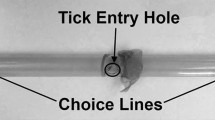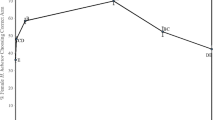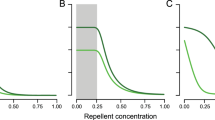Abstract
In the first section of this review, the stimuli involved in orienting biting flies to their hosts from a distance are discussed under the following headings: (1) Appetitive search—driven by endogenous rhythms and hunger. (2) Activation—the switchover from search behaviour to active host-location brought about in the insect by host-originating stimuli including, depending on species, carbon dioxide, visual contact, and specific host odours. (3) Attraction—the process of active host-location through which the insect comes into the immediate vicinity of the host. This relies on host-originating stimuli including visual contact and olfactory stimuli such as carbon dioxide, volatiles such as acetone, and specific, usually very potent host-related odours. The second part of this review discusses the properties of the odour plumes biting flies rely on to locate the host. Possible methods of host-location using air-borne odour plumes are presented and the “positive anemotaxis” model based on moth pheromone work is stressed.
Résumé
La première section de ce compte rendu examine les stimulus qui dirigent de loin les mouches piquantes vers leurs hôtes et les présente sour les titres suivants: (1) La recherche de l’hôte—commandée par des forces appetitives, par les rythmes endogènes et par la faim. (2) L’activation—l’arrêt de la recherche de l’hôte par vole non-dirigé et le début de la localization active de l’hôte, un comportement suscité par les stimulus originant de l’hôte. Ceux-ci, dépendant de l’espèce de mouche, peuvent inclure le gaz carbonique, la vue de l’hote et des odeurs spécifiques provenant de l’hôte. (3) L’attraction—la procédure de la localization active par laquelle l’insecte se rapproche très près de l’hôte. Elle dépend de stimulus originant de l’hôte: le contact visuel, le gaz carbonique, les produits chimiques volatils comme l’acétone par exemple, et des odours spécifiques et puissants liées a l’hôte. La seconde partie de ce compte rendue considère les propriétés du panache d’odeur avec lequel les mouches piquantes repèrent leurs hôtes. Des façons emportés par la vent sont suggérées en entrant en ligne de compte la modèle de “anemotaxis” positif, trouvé dans la littérature sur les pheromones des papillons de nuit.
Similar content being viewed by others
References
Acree F. Jr., Turner R. B., Gouck H. K., Beroza M. and Smith N. (1968) L-lactic acid: A mosquito attractant isolated from humans. Science 161, 1346–1347.
Allan S. A., Day J. F. and Edman J. D. (1987) Visual ecology of biting flies. A. Rev. Ent. 32, 297–316.
Allan S. A. and Stoffolano J. G. Jr. (1986a) Effects of background contrast on visual attraction and orientation of Tabanus nigrovittatus (Diptera: Tabanidae). Environ. Em. 15, 689–694.
Allan S. A. and Stoffolano J. G. Jr. (1986b) The effects of hue and intensity on visual attraction of adult Tabanus nigrovittatus (Diptera: Tabanidae). J. Med. Em. 23, 83–91.
Askew R. R. (1971) Parasitic Insects. American Elsevier Pub. Co., New York.
Bidlingmayer W. L. and Hem D. G. (1979) Mosquito (Diptera: Culicidae) flight behaviour near conspicuous objects. Bull. Ent. Res. 69, 691–700.
Bidlingmayer W. L. and Hem D. G. (1980) The range of visual attraction and the effect of visual attractants upon mosquito (Diptera: Culicidae) flight. Bull. ent. Res. 70, 321–342.
Bracken G. K., Hanec W. and Thorsteinson A. J. (1962) The orientation of horse flies and deer flies (Tabanidae: Diptera). II. The role of some visual factors in the attractiveness of decoy silhouettes. Can. J. Zool. 40, 685–695.
Bradbury W. C and Bennett G. F. (1974) Behaviour of adult Simuliidae (Diptera). I. Response to colour and shape. Can. J. Zool. 52, 251–259.
Brady J. (1970) Characteristics of spontaneous activity in tsetse flies. Nature 228, 286–287.
Brady J. (1972) Spontaneous circadian components of tsetse fly activity. J. Insect Physiol. 18, 471–484.
Browne S. M. and Bennett G. F. (1980) Color and shape as mediators of host-seeking responses of simuliids and tabanids (Diptera) in the Tantramar marshes, New Brunswick, Canada. J. Med. Ent. 17, 58–62.
Bursell E. (1984a) Observations on the orientation of tsetse flies (Glossina pallidipes) to wind-borne odours. Physiol. Ent. 9, 133–137.
Bursell E. (1984b) Effects of host odour on the behaviour of tsetse. Insect Sci. Applic. 5, 345–349.
Cardé R. T. (1984) Chemo-orientation in flying insects. In: Chemical Ecology of Insects (Edited by Bell W. J. and Cardé R. T.), pp. 111–124. Chapman and Hall Ltd., London.
Compton-Knox P. and Hayes K. L. (1972) Attraction of Tabanus spp. (Diptera: Tabanidae) to traps baited with carbon dioxide and other chemicals. Environ. Ent. 1, 323–326.
David C. T., Kennedy J. S., Ludlow A. R., Perry J. N. and Wall C. (1982) A reappraisal of insect flight towards a distant point source of wind-borne odor. J. Chem. Ecol. 8, 1207–1215.
Davis E. E. (1984a) Regulation of sensitivity in peripheral chemoreceptor systems for host-seeking behaviour by a hemolymph-borne factor in Aedes aegypti. J. Insect Physiol. 30, 179–183.
Davis E. E. (1984b) Development of lactic acid-receptor sensitivity and host-seeking behavior in newly emerged female Aedes aegypti mosquitoes. J. Insect Physiol. 30, 211–215.
Davis E. E. and Sokolove P. G. (1976) Lactic acid sensitive receptors on the antennae of the mosquito, Aedes aegypti. J. Comp. Physiol. 105, 43–54.
Daykin P. N., Kellogg F. E. and Wright R. H. (1965) Host-finding and repulsion in Aedes aegypti. Can. Ent. 97, 239–263.
Dethier V. G. (1976) The Hungry Fly. Harvard Univ. Press, Cambridge, Mass.
Elkinton J. S. and Cardé R. T. (1984) Odor dispersion. In: Chemical Ecology of Insects. (Edited by Bell W. J. and Cardé R. T.), pp. 73–91. Chapman and Hall Ltd., London.
Fallis A. M., Bennett G. F., Griggs G. and Allen T. (1967) Collecting Simulium venustum females in fan traps and on silhouettes with the aid of carbon dioxide. Can. J. Zool. 45, 1011–1017.
Fallis A. M. and Raybould J. N. (1975) Response of two African simuliids to silhouettes and carbon dioxide. J. Med. Ent. 12, 349–351.
Fallis A. M. and Smith S. M. (1964) Ether extracts from birds and C02 as attractants for some ornithophilic simuliids. Can. J. Zool. 42, 723–730.
Farkas S. R. and Shorey H. H. (1972) Chemical trail-following by flying insects: a mechanism for orientation to a distant odor source. Science 178, 67–68.
Fredeen F. J. H. (1961) A trap for studying the attacking behaviour of black flies, Simulium arcticum Mall. Can. Ent. 93, 73–78.
Friend W. G. and Smith J. J. B. (1977) Factors affecting feeding by blood-sucking insects. A. Rev. Ent. 22, 309–331.
Gibson G. and Brady J. (1985) “Anemotactic” flight paths of tsetse flies in relation to host odour: a preliminary video study in nature of the response to loss of odour. Physiol. Ent. 10, 395–406.
Gillies M. T. (1980) The role of carbon dioxide in host-finding by mosquitoes (Diptera: Culicidae). Bull. ent. Res. 70, 525–532.
Hall D. R., Beevor P. S., Cork A., Nesbitt B. F. and Vale G. A. (1984) l-octen-3-ol: A potent olfactory stimulant and attractant for tsetse isolated from cattle odours. Insect Sci. Applic. 5, 335–339.
Hassanali A., MacDowell P. G., Owaga M. L. A. and Saini R. K. (1986) Identification of tsetse attractants from excretory products of a wild host animal, Syncerus coffer. Insect Sci. Applic. 7, 5–9.
Holbrook F. R. (1985) A comparison of three traps for adult Culicoides variipennis (Ceratopogonidae ). J. Am. Mosq. Control Assoc. 1, 379–381.
Jones M. D. R. (1976) Persistence in continuous light of a circadian rhythm in the mosquito Culex pipiens fatigans Wied. Nature 261, 491–492.
Jones M. D. R. and Gubbins S. J. (1978) Changes in the circadian flight activity of the mosquito Anopheles gam-biae in relation to insemination, feeding and oviposition. Physiol. Ent. 3, 213–220.
Kellogg F. E. and Wright R. H. (1962) The guidance of flying insects. V. Mosquito attraction. Can. Ent. 94, 1009–1016.
Kennedy J. S. (1939) The visual responses of flying mosquitoes. Proc. Zool. Soc. London 109, 221–242.
Kennedy J. S. (1983) Zigzagging and casting as a programmed response to wind-borne odour: A review. Physiol. Ent. 8, 109–120.
Khan A. A. and Maibach H. I. (1966) Quantification of the effect of several stimuli on landing and probing by Aedes aegypti. J. Econ. Ent. 59, 902–905.
Lillie T. H., Jones R. H., Marquardt W. C. and Simpson R. G. (1979) A lightweight, portable and inexpensive baffle trap for collecting Culicoides variipennis (Diptera: Ceratopogonidae). Mosq. News 39, 675–677.
McIver S. B. (1974) Fine structure of antennal grooved pegs of the mosquito, Aedes aegypti. Cell Tiss. Res. 153, 327–337.
Miller J. R. and Strickler K. L. (1984) Finding and accepting host plants. In: Chemical Ecology of Insects (Edited by Bell W. J. and Cardé R. T.), pp. 127–157. Chapman and Hall Pub. Co.
Murlis J. and Jones C. D. (1981) Fine-scale structure of odour plumes in relation to insect orientation to distant pheromone and other attractant sources. Physiol. Ent. 6, 71–86.
Nayar J. K. and Sauerman D. M. (1971) The effect of light regimes on the circadian rhythm of flight activity in the mosquito Aedes taeniorhynchus. J. Exp. Biol. 54, 745–756.
Nelson R. L. (1965) Carbon dioxide as an attractant for Culicoides. J. Med. Ent. 2, 56–57.
Owaga M. L. A. (1984) Preliminary observation of the efficacy of olfactory attractants derived from wild hosts of tsetse. Insect Sci. Applic. 5, 87–90.
Owaga M. L. A. (1985) Observations of the efficacy of buffalo urine as a potent olfactory attractant for Glossina pallidipes Austen. Insect Sci. Applic. 6, 561–566.
Peschken D. and Thorsteinson A. J. (1965) Visual orientation of black flies (Simuliidae: Diptera) to colour, shape and movement of targets. Ent. Exp. Appl. 8, 282–288.
Price G. D., Smith N. and Carlson D. A. (1979) The attraction of female mosquitoes (Anopheles quadrimacu-latus Say) to stored human emanations in conjunction with adjusted levels of relative humidity, temperature, and carbon dioxide. J. Chem. Ecol. 5, 383–395.
Roberts R. H. (1972) Relative attractiveness of C02 and a steer to Tabanidae, Culicidae, and Stomoxys calcitrans. Mosq. News 32, 208–211.
Saunders D. S. (1982) Insect Clocks. Pergamon Press, Toronto, Ont.
Schöne H. (1984) The Spatial Control of Animals and Man. Princeton Univ. Press, Princeton, N.J.
Schreck C. E., Smith N., Carlson D. A., Price G. D., Haile D. and Godwin D. R. (1981) A material isolated from human hands that attracts female mosquitoes. J. Chem. Ecol. 8, 429–438.
Smith C. N., Smith N., Gouck H. K., Weidhaas D. E., Gilbert I. H., Mayer M. S., Smittle B. J. and Hoffbauer A. (1970) L-Lactic acid as a factor in the attraction of Aedes aegypti (Diptera: Culicidae) to human hosts. Ann. ent. Soc. Am. 63, 760–770.
Sutcliffe J. F. (1986) Black fly host location: a review. Can. J. Zool. 64, 1041–1053.
Sutton O. G. (1947) The problem of diffusion in the lower atmosphere. Quart. J. Roy. Meteorol. Soc. 73, 257–281.
Sutton O. G. (1953) Micrometeorology. McGraw-Hill Pub. Co., New York.
Taylor B. and Jones M. D. R. (1969) The circadian rhythm of flight activity in the mosquito Aedes aegypti (L.): the phase-setting effects of light-on and light-off. J. Exp. Biol. 51, 59–70.
Thompson B. H. (1976a) Studies on the attraction of Simulium damnosum s.l. (Diptera: Simuliidae) to its hosts. I. The relative importance of sight, exhaled breath and smell. Tropenmed. Parasit. 27, 455–473.
Thompson B. H. (1976b) Studies on the attraction of Simulium damnosum s.l. (Diptera: Simuliidae). II. The nature of the substances on the human skin responsible for attractant olfactory stimuli. Tropenmed. Parasit. 27, 83–90.
Thorsteinson A. J., Bracken B. K. and Tostowaryk W. (1966) The orientation behaviour of horse flies and deer flies (Tabanidae: Diptera). V. The influence of the number and inclination of reflecting surfaces on attractiveness to tabanids of glossy black polyhedra. Can. J. Zool. 44, 275–279.
Vale G. A. (1974) The responses of tsetse flies (Diptera: Glossinidae) to mobile and stationary baits. Bull. ent. Res. 64, 545–588.
Vale G. A. (1980) Field studies of the responses of tsetse flies (Glossinidae) and other Diptera to carbon dioxide, acetone and other chemicals. Bull. ent. Res 70, 563–570.
Vale G. A. (1984) The responses of Glossina (Glossinidae ) and other Diptera to odour plumes in the field. Bull. ent. Res. 74, 143–152.
Vale G. A. and Hall D. R. (1985a) The role of l-octen-3-ol, acetone, and carbon dioxide in the attraction of tsetse flies, Glossina spp. (Diptera: Glossinidae) to ox odour. Bull. ent. Res. 75, 209–217.
Vale G. A. and Hall D. R. (1985b) The use of l-octen-3-ol, acetone and carbon dioxide to improve baits for tsetse flies, Glossina spp. (Diptera: Glossinidae). Bull. ent. Res. 75, 219–231.
Vale G. A., Hargrove J. W., Cockbill G. F. and Phelps R. J. (1986) Field trials of bait to control populations of Glossina morsitans morsitans Westwood and G. pallidipes Austen (Diptera: Glossinidae). Bull. ent. Res. 76, 179–193.
Warnes M. L. and Finlayson L. H. (1985a) Responses of the stable fly, Stomoxys calcitrans (L.) (Diptera: Muscidae), to carbon dioxide and host odours. I. Activation. Bull. ent. Res. 75, 519–527.
Warnes M. L. and Finlayson L. H. (1985b) Responses of the stable fly, Stomoxys calcitrans (L.) (Diptera: Muscidae), to carbon dioxide and host odours. II. Orientation. Bull. ent. Res. 75, 717–727.
Warnes M. L. and Finlayson L. H. (1986) Electro-antennogram responses of the stable fly, Stomoxys calcitrans, to carbon dioxide and other odours. Physiol. Ent. 11, 469–473.
Wright R. H. (1958) The olfactory guidance of flying insects. Can. Ent. 90, 81–89.
Author information
Authors and Affiliations
Rights and permissions
About this article
Cite this article
Sutcliffe, J.F. Distance Orientation of Biting Flies to Their Hosts. Int J Trop Insect Sci 8, 611–616 (1987). https://doi.org/10.1017/S1742758400022682
Received:
Published:
Issue Date:
DOI: https://doi.org/10.1017/S1742758400022682




